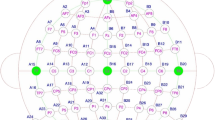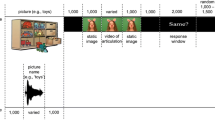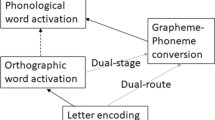Abstract
This study investigated whether asynchrony ofspeed of processing (SOP) betweenvisual-orthographic and auditory-phonologicalmodalities can account for word recognitiondeficits among dyslexic readers. SOP amongelementary school dyslexic readers was comparedto that of chronologically age-matched normalreaders. SOP was assessed using nonlinguisticand linguistic auditory and visual low-leveltasks and higher-level orthographic andphonological tasks. Behavioral andelectrophysiological (ERP) measures of SOP wereobtained. Data indicated that dyslexic readerswere significantly slower than control readersin most of the experimental tasks. Moreover,dyslexics revealed a systematic SOP gap betweenthe auditory-phonological and thevisual-orthographic modalities. This gap wasfound in both P200 and P300 latencies, andexplained most of the variance in wordrecognition. A theory is proposed suggestingthat asynchrony between the processing rates ofthe visual and the auditory modalities may bean underlying cause of dyslexia.
Similar content being viewed by others
References
Ackerman, P.T., Arnhalt, J.M. & Dykman, R.A. (1986). Inferential word decoding weakness in RD children, Learning Disability Quarterly 9: 315-324.
Ackerman, P.T. & Dykman, R.A. (1993). Phonological processes, confrontation naming, and immediate memory in dyslexia, Journal of Learning Disabilities 26: 597-609.
Ackerman, P.T., Dykman, R.A. & Oglesby, D.M. (1994). Visual event-related potentials of dyslexic children to rhyming and nonrhyming stimuli, Journal of Clinical and Experimental Neuropsychology 16: 138-154.
Adams, M.J. (1990). Beginning to read: Thinking and learning about print. Cambridge, MA: MIT Press.
American Psychological Association (1994). Diagnostic and statistical manual of mental disorders, 4th edn. Washington, DC: Author.
Anderson, J.R. (1990). Cognitive psychology and its implications. New York: W.H. Freeman.
Baddeley, A.D. (1986). Working memory. Oxford: Clarendon Press.
Badian, N.A. (1995). Predicting reading ability over the long-term: The changing roles of letter naming, phonological awareness and orthographic processing, Annals of Dyslexia: An Interdisciplinary Journal 45: 79-86.
Badian, N.A. (1996). Dyslexia: A validation of the concept at two age levels, Journal of Learning Disabilities 29(1): 102-112.
Barker, T.A., Torgesen, J.K. & Wagner, R.K. (1992). The role of orthographic processing skills on five different reading tasks, Reading Research Quarterly 27(4): 334-335.
Barnea, A., Lamm, O., Epstein, R. & Pratt, H. (1994). Brain potentials from dyslexic children recorded during short-term memory tasks, International Journal of Neuroscience 74: 227-237.
Barnea, A. & Breznitz, Z. (1998). Phonological and orthographic processing of Hebrew words: Electrophysiological aspects, Journal of Genetic Psychology 159(4): 492-504.
Barron, R.W. (1991). Proto-literacy, literacy, and the acquisition of phonological awareness, Learning and Individual Differences 31: 243-255.
Ben-Dror, I & Shani,M. (1996). Phonological segmentation test. Unpublished test. University of Haifa, Haifa.
Bentin, S. (1989). Electrophysiological studies of visual word perception, lexical organization, and semantic processing: A tutorial review, Language and Speech 32: 205-220.
Berninger, V.W. (1987). Global component, and serial processing of printed words in beginning reading, Journal of Experimental Child Psychology 43: 387-418.
Blachman, B.A. (1994). What we have learned from longitudinal studies of phonological processing and reading, and some unanswered questions: A response to Torgesen, Wagner and Rashotte, Journal of Learning Disabilities 27: 287-291.
Bowers, P.G, Steffy, R. & Tate, E. (1988). Comparison of the effects of I.Q control methods on memory and naming speed predictors of reading disability, Reading Research Quarterly 23: 304-309.
Bowers, P.G. & Wolf, M. (1993). Theoretical links among naming speed, precise timing mechanisms and orthographic skill in dyslexia, Reading and Writing: An Interdiciplinary Journal 5: 69-85.
Brandeis, D. & Lehmann, D. (1994). ERP mapping: a tool for assessing language disorders. In: H.J. Heinze, T.F. Mante & G.R. Mangun (eds.), Cognitive electrophysiology (pp. 242-250). Boston: Birkhauser.
Breznitz, Z. (1987). Increasing first-graders' reading accuracy and comprehension by accelerating their reading rates, Journal of Educational Psychology 79: 236-242.
Breznitz, Z. (1997a). Enhancing the reading of dyslexics by reading acceleration and auditory masking, Journal of Educational Psychology 89(1): 236-246.
Breznitz, Z.(1997b). The effect of accelerated reading rate on memory for text among dyslexic readers, Journal of Educational Psychology 89: 287-299.
Breznitz, Z. (1997c). Temporal processing test. Unpublished Test. University of Haifa.
Breznitz, Z. (submitted). Speed of phonological and orthographic processing among adult dyslexic readers: Electrophysiological aspects, Brain and Language. Breznitz, Z. & Meyler, A. (submitted). Lower-level auditory and visual processing among adult dyslexic readers: Electrophysiological evidence.
Breznitz, Z. (in preparation). The identification and the characteristics of reading disabilities in Israel, National Project.
Breznitz, Z., DeMarco, A. & Hakerem, G. (1993). Topographic measures of cerebral activity during reading of text at fast-and slow-paced rates, Brain Topography 6(2): 117-121.
Breznitz, Z., DeMarco, A., Shammi, P. & Hakerem, G. (1994). Self-paced versus fast-paced reading rates and their effect upon comprehension and event-related potentials, Journal of Genetic Psychology 155(4): 397-408.
Breznitz, Z. & Share, D.L. (1992). The effect of accelerated reading rate on memory of text, Journal of Educational Psychology 84(2): 193-199.
Carver, R.P. (1990). Reading Rate: A review of research and theory. San Diego, CA: Academic Press
Ciesielski, K.J. (1989). Event related potentials in children with specific visual cognitive disability, Neuropsychologia 27: 303-313.
Cohen, J. & Bresline, P.W. (1984). Visual evoked responses in dyslexic children, Annals of The New York Academy of Science 425: 338-343.
Compton, D.L. & Carlisle, J.F. (1994). Speed of word recognition as a distinguishing characteristic of reading disabilities, Eductional Psychology Review 6: 115-140.
Corcos, E., Kruk, R.S. & Willows, D.M. (1993). The processing of orthographic information. In: D.N.Willows, R.S. Kruk & E. Corcos (eds.), Visual processing in reading and reading disabilities (pp. 163-190). Hillsdale, NJ: Erlbaum.
Cunningham, A.E. & Stanovich, K.E. (1990). Assessing print exposure and orthographic processing skill in children: A quick measure of reading experience, Journal of Educational Psychology 82: 733-740.
Davidson, R.J. & Saron, C.D. (1992). Evoked potentials measures of interhemispheric transfer time in reading disabeled and normal boys, Developmental Neuropsychology 8: 261-277.
Denkla, M.B. & Rudel, R.G. (1976). Naming of objects by dyslexic and other learning disabled children, Brain and Language 3: 1-15.
Doi, L.M. & Manis. F.R. (1996). The impact of speeded naming ability on reading performance. Paper presented at the meeting of the Society for the Scientific Study of Reading, New York.
Donchin, E. (1981). Surprise!... surprise. Psychophysiology 18: 493-451.
Eden, G.F., Stein, J.F. & Wood, F.B. (1993). Visuospatial ability and language processing in reading disabled and normal children. In: S.F. Wright & R. Groner (eds.), Facets of dyslexia and its remediation (pp. 321-336). Amsterdam: Elsevier.
Geva, E. & Share, D. (1995). Test of orthographic conventions. Unpublished test. University of Haifa, Haifa.
Gough, P.B. & Tunmer,W.E. (1986). Decoding, reading, and reading disability, Remedial and Special Education 7: 6-10.
Greene, B.A. & Royer, J.M. (1994). A developmental review of response time data that support a cognitive components model of reading, Eductional Psychology Review 6: 141-172.
Halgren, E. (1990). Insights from evoked potentials into the neuropsychological mechansims of reading. In: A.B. Scheibel & A.F. Wechsler (eds.), Neurobiology of higher cognitive function (pp. 103-150). New York: Guilford Press.
Harter, M.R., Holcomb, P.J., Anllo-Vento, L., Wood, F.B. & Schroeder, M.M. (1988). Separate brain potential characteristics in children with reading disability and attention deficit disorder: Color and letter-relevance effects, Brain and Cognition 7: 115-140.
Harter, M.R., Deiring, S. & Wood, F.B. (1988). Separate brain potential characteristics in children with reading disability and attention deficit disorder: Relevance-independent effects, Brain and Cognition 7: 54-86.
Holcomb, P.J., Ackerman, P.T. & Dykman, R.A. (1986). Auditory event-related potentials in attention and reading disabled boys, International Journal of Psychophysiology 3: 263-273.
Hynd G.W. & Semrud-Clikeman, M. (1989). Dyslexia and neurodevelopmental pathology: Relationships to cognition, intelligence and reading skill acquisition, Journal of Learning Disabilities 22: 204-216.
Jasper, H.H. (1958). The ten-twenty electrode system of the International Federation, Electroencephalographyand Clinical Neurophysiology 10: 371-375.
Johnson, C.J. (1995). Effects of color on children's naming of pictures, Perceptual and Motor Skills 80: 1091-1101.
Kail, R. & Salthouse, T.A. (1994). Processing speed as a mental capacity, Acta Psychologica 86: 199-225.
Klein, H.A. & Klein, G.A. (1972). Studying the use of context for word identification decisions. Paper presented at the meeting for the National reading Conference, New Orleans.
Liberman, I.Y. & Shankweiler, D. (1991). Phonology and beginning to read. In: L. Reiben & C. A. Perfetti (eds.), Learning to read (pp. 3-17). Hillsdale, NJ: Erlbaum.
Lovegrove, W.J. & Staghuis, W. (1989). How reliably are visual differences found in dyslexics?, Irish Journal of Psychology 10: 542-550.
Lovett, M.W. (1992). Developmental dyslexia. In: S.J. Seglowitz & I. Rapin (eds.), Handbook of neuropsychology: Vol 7: Child neuropsychology (pp. 163-185). New York: Elsevier.
Ministry of Education, Israel (1994). Comprehension test for grade 4. Jerusalem.
Neville, H.J., Coffey, S.A., Holcomb, P.J., & Tallal, P. (1993). The neurobiology of sensory and language processing in language-impaired children, Journal of Cognitive Neuroscience 5: 235-253.
Nicolson, R.I. & Fawcett, A.J. (1993a). Towards the origins of dyslexia. In: S.F. Wright & R. Groner (eds.), Facets of dyslexia and its remediation (pp. 371-393). Amsterdam: Elsevier.
Nicolson, R.I. & Fawcett, A.J. (1993b). Children with dyslexia automatize temporal skills more slowly, Annals of the New York Academy of Sciences 682: 390-392.
Nicolson, R.I. & Fawcett, A.J. (1994). Naming speed in children with dyslexia, Journal of Learning Disabilities 27: 641-646.
Nicolson, R.I. & Fawcett, A.J. (1995). Persistent deficits in motor skills of children with dyslexia, Journal of Motor Behavior 27: 641-646.
Nitzan Learning Disability Center (1988). Reading skills test. Nitzan: Tel Aviv.
Ojemann, G.A. (1983). Brain organization for language from the perspective of electrical stimulation mapping, Behavioural Brain Science 6: 189-230.
Perfetti, C. (1992). The representation problem in reading acquisition. In: P.B. Gough, L.C. Ehri & R. Trieman (eds.), Reading acquisition (pp. 145-174). Hillsdale, NJ: Erlbaum.
Raven, J.C. (1965). Advanced progressive matrices sets I and II. London: H.K. Lewis.
Regan, D. (1989). Human brain electrophysiology: Evoked potentials and evoked magnetic fields in science and medicine, New York: Elsevier.
Rosenzweig, M.R. & Bennett, E.L. (1996). Psychobiology of plasticity: Effects of trainning and experience on brain and behavoir, Behavioural Brain Research 78: 57-65.
Seidenberg, M.S. (1990). Dyslexia in a computational model of word recognition in reading. In: P.B. Gough, L.C. Ehri & R. Trieman (eds.), Reading acquisition (pp. 243-273). Hillsdale, NJ: Erlbaum.
Shatil, E. (1995). One-minute test for words. Unpublished test. University of Haifa. Haifa.
Stanovich, K.E. (1991). Word recognition: Changing perspectives. In: P.D. Pearson (ed.), Handbook of reading research, Vol. 2 (pp. 418-452). White Plains, NY: Longman.
Stanovich, K.E. & West, R.F. (1989). Exposure to print and orthographic processing, Reading Research Quarterly 24: 402-433.
Tallal, P., Miller, S. & Fitch, R.H. (1993). Neurobiological basis of speech: A case of the preeminence of temporal processing. In: P. Tallal, A.M. Galaburda, R.R. Llinas & C. von Eurler (eds.), Temporal information processing in the nervous system. Annals of the New York Academy of Sciences, Vol. 682 (pp. 27-47). New York: New York Academy of Sciences.
Taylor, M.T. & Keenan, N.K. (1990). Event related potentials to visual and language stimuli in normal and dyslexic children, Psychophysiology 27: 318-327.
Tzeng, O. & Wang, W.S. (1984). Search for a common neurocognitive mechanism for language and movements, American Journal of Physiology 246: 904-911.
Watson, B.U. (1988). Auditory temporal processing and reading disability, Journal of the Acoustical Society of America 84 (suppl. 1): Y21.
Watson, B.U. (1992). Auditory temporal acuity in normally achieving and learning disabled college students, Journal of Speech and Hearning Research 35: 148-156.
Watson, B.U. & Miller, T.K. (1993). Auditory perception. phonological processing, and reading ability/disability, Journal of Speech and Hearing Research 36: 850-863.
Wechsler, D. (1976). Wechsler intelligence scale for childen-revised (WISC-R). Winsor: NFER.
Wechsler, D. (1994). Wechsler intelligence scale for adults (WAIS-3). Winsor: NFER.
Wolf, M. (1986). RAS (Rapid Alternating Stimuli) naming test. Tufts University, Boston.
Wolf,M. (1991). Naming speed and reading: The contribution of the cognitive neurosciences, Reading Research Quarterly 26(2): 123-141.
Wolf, M., Bally, H. & Morris, R. (1986). Automaticity, retrieval processes, and reading: Alongitudinal study in avarage and impaired readers, Child Development 57: 988-1000.
Wright, S.F. & Groner, R., eds. (1993). Facets of dyslexia and its remediation. Amsterdam: Elsevier.
Yap, R. & van der Leij, A. (1993). Rate of elementary symbol processing in dyslexics. In: S.F. Wright & R. Groner (eds.), Facets of dyslexia and its remediation (pp. 337-348). Amsterdam: Elsevier.
Zecker, S.G. (1991). The orthographic code: Developmetnal trends in reading-disabled and normally-achieving children, Annals of Dyslexia 41: 178-192.
Author information
Authors and Affiliations
Corresponding author
Rights and permissions
About this article
Cite this article
Breznitz, Z. Asynchrony of visual-orthographic and auditory-phonological word recognition processes: An underlying factor in dyslexia. Reading and Writing 15, 15–42 (2002). https://doi.org/10.1023/A:1013864203452
Issue Date:
DOI: https://doi.org/10.1023/A:1013864203452




